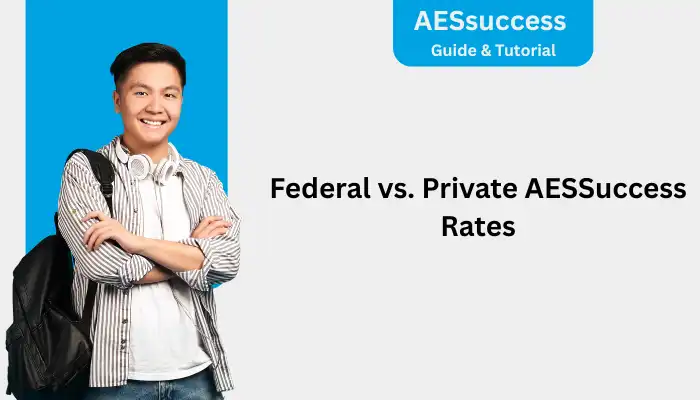Knowing AESsuccess rate is key to understanding your student loans with American Education Services (AES), a major player in student loan servicing. When I first used AESsuccess login, I was overwhelmed, but these rates determine your loan management costs. Mastering them boosts your financial literacy and unlocks smart repayment strategies.

In this guide, I’ll break down what AES success rate means, how AES calculates interest, the differences between federal student loans and private student loans, and how to leverage the AES success rate calculator for education finance. Ready to take charge? Let’s dive in!

AESsuccess Rate: What Is It?
So, what’s this AESsuccess rate or AES success rate everyone’s talking about? These terms refer to the interest rates on loans serviced by AES, whether they’re federal student loans or private student loans.
Here’s the truth: AES doesn’t set these rates! Federal loan rates are determined by Congress, while private loan rates come from the lender who issued your loan. AES, as a loan servicer, handles the loan agreement, manages interest calculation, and provides borrower information through AES loan terms on AESsuccess.org.
Here’s the lowdown:
- Federal loans: Fixed rates set by law, shown as an annual percentage rate (APR).
- Private loans: Rates vary based on lender, credit, and market conditions.
- AES’s role: They lay out your student loan interest details clearly in your account.
When I first checked my AES success rate, I found it by logging into my account. It’s your first step to understanding interest and avoiding surprises.
Use the AESsuccess rate calculator to see how these rates impact your AESsuccess payments—it’s a must for loan understanding!
Types Of AESsuccess Rates
Interest rates come in two main types: fixed and variable. Knowing which one applies to your AESsuccess rate or AES success rate is crucial for financial planning. Let’s break them down so you can make smart choices.
Fixed Interest Rates
Fixed rates are the reliable choice, common in federal loan types like Direct Subsidized or Unsubsidized Loans. They stay the same throughout your loan term, giving you interest rate stability. My federal loan had a fixed AESsuccess rate of 4.99%, which made budgeting a breeze, no surprises!
This repayment predictability keeps your loan cost steady, perfect for anyone who wants certainty in their financial planning.
Variable Interest Rates
Variable rates, often found in private loan types, are tied to market indexes, so they can go up or down. A friend of mine took a private loan with a variable AES success rate starting at 3.5%. It was great… until market fluctuations pushed it to 6%, and their payments spiked.
If you choose a variable rate, be ready for changes in your interest rate impact and use the AES success rate calculator to plan for potential shifts.
Both types affect your AESsuccess rate experience differently. Fixed rates offer peace of mind, while variable rates might save money upfront but come with risks. Pick what fits your financial planning style.

How AESsuccess Calculates Your Loan Interest?
Let’s get nerdy (but fun!) about how AES calculates your AESsuccess rate or AES success rate. AES uses a daily interest accrual method, meaning interest adds up every single day, even if your loan isn’t in repayment. The formula is simple:
(Loan Balance × Interest Rate) ÷ 365
This gives you the daily interest charges. These pile up through compounding interest, increasing your total interest paid if you’re not careful. I learned this the hard way when I ignored my principal balance for too long—interest was sneaking up on me!
Real-Life Example:
Take Sara Student, who has a $10,000 principal balance with a 6% AES success rate:
- Daily interest = (0.06 × $10,000) ÷ 365 = $1.64/day
- Over 30 days, that’s $1.64 × 30 = $49.20 in interest
This interest gets added to your loan balance unless your payment allocation covers it. Your payments only cover accrued interest charges, not future interest, and then go toward the principal balance.
Tools like the AESsuccess rate calculator help you see how payments affect your loan amortization. Pro tip: Pay extra toward the principal to keep interest accrual in check—it saved me hundreds!
How Payments Apply To Interest And Current Principal Balance?
Understanding how your payments are applied is key to managing your AESsuccess rate or AES success rate. Interest accrues daily from the day your loan is disbursed until your final payment. When you make a payment, AES counts the days since your last payment and applies it based on your loan agreement or AESsuccess repayment plan.
Here’s how it typically works:
- Standard Application:
- First, payments cover accrued interest charges.
- Next, any late fees (if applicable).
- Finally, the remaining amount goes to your principal balance.
- Custom Plans:
- Some plans, like income-driven repayment, may apply payments differently. Check your Loan Details section via AES account login.
I once made a late payment, and it was a bummer to see most of it go to fees instead of my principal balance. To avoid this, make payments on time! Direct Debit is a lifesaver; it automates payments on the due date, keeping your total interest paid low.
Log in to AESsuccess.org to review your payment allocation and stay on top of your loan management. For more details, check AES’s Interest FAQ.

Federal vs. Private AESSuccess Rates
Your AES success rate or AES success rate depends on whether you have a federal or private loan. Let’s compare the two to help you navigate.
Federal Student Loan Rates
Federal student loan rates, set by Congress, typically range from 4.99% to 7.54% for loans like Direct Subsidized, Unsubsidized, or PLUS loans. Older FFEL Program loans, still serviced by AES, have similar fixed rates.
These don’t rely on your credit score impact, making them accessible based on loan eligibility like income or need. My federal AESsuccess rate was predictable, which made planning a breeze.
Private Student Loan Rates
Private student loan rates can range from 3% to 13%, depending on your lender, credit score impact, cosigner benefits, and loan term influence.
When I got a private loan, my cosigner’s good credit scored me a lower AES success rate, but it was variable and crept up later. Use the AES success rate calculator for interest rate comparison and to anticipate changes.
Knowing these differences helps you craft repayment strategies that fit your budget.
How to Check Your AESsuccess Rate?
Checking your AESsuccess rate or AES success rate is easy, and I’ll guide you through it. AES makes it simple to access your loan information via AESsuccess.org. Here’s how:
Steps to Check Your Rate:
- Log in: Go to the online portal, use your AES account login, and access your borrower dashboard.
- Find loan details: Navigate to the Loan Details section for loan type verification (fixed or variable) and current rate.
- Other sources: Check your monthly statement, call an AESsuccess customer service, or log into the National Student Loan Database (NSLDS) for checking loan details.
- Monitor regularly: Set a reminder to track monitoring interest rates, especially for variable rates.
When I first explored my account management, the borrower dashboard was surprisingly clear. Use it for managing student loans and maintaining financial oversight. Bonus: The AESsuccess rate calculator is perfect for testing repayment scenarios.
How Interest Rates Affect Your Monthly Payment?
Your AES success rate or AES success rate directly shapes your monthly payments, and understanding this can save you money. Higher rates mean higher payments, especially with variable private loan types.
Here’s a comparison:
| Loan Amount | Interest Rate | Term | Monthly Payment |
|---|---|---|---|
| $20,000 | 5% (Fixed) | 10 years | $212 |
| $20,000 | 8% (Variable) | 10 years | $243 (can vary) |
Using the AES success rate calculator, I saw how extra payments toward my principal balance cut my total interest paid. Variable rates can mess with repayment predictability, so budget for potential increases. A cool tip? Sign up for Direct Debit for a 0.25% rate reduction—it’s an easy win for financial planning!
How To Lower Your AESsuccess Interest Rates?
Lowering your AESsuccess rate or AES success rate is tricky since AES doesn’t set the rates. But don’t worry, I’ve got some strategies! Here’s what you can do:
Options to Lower Your Rate
You can opt for the following options for lowering the your interest rate:
- Direct Debit discount: Enroll in Direct Debit to automate payments and get a 0.25% reduction on your student loan interest. I did this, and it was an easy way to save.
- Refinancing: Take out a new loan to pay off your existing one, potentially lowering your AES success rate. This works if rates have dropped or your credit has improved. I refinanced a private loan and cut my rate by 1.5%—huge win!
- Consolidation: For federal student loans, consolidation combines loans into one but may not lower your AES success rate. It simplifies loan management, though.
Be cautious: Refinancing federal loans turns them into private loans, meaning you lose benefits like income-driven repayment.
I almost made this mistake—use the AESsuccess rate calculator to weigh savings against lost borrower resources. Check AES’s Interest FAQ for more insights.
Frequently Asked Questions(FAQs) on AESsuccess Rates
Got questions about AESsuccess rate or AES success rate? I’ve got answers! Here are the most common queries I hear from borrowers, based on my own experience and AES’s borrower resources.
Can I lower my AESsuccess rate?
Yes, you can lower your interest by opting for the direct debit option, or refinance a new loan or Consolidate federal student loans to simplify loan management, though it may not lower your AES success rate.
What’s the benefit of Direct Debit for my AES interest rate?
The benefit of the Direct Debit on the AES interest rate is that it automates payments, ensuring they’re on time and reducing your rate by 0.25%. This lowers your student loan interest over time.
How are interest rates calculated?
Interest rates are calculated based on the tupe of the Fedral loan, commonly if you are in school, interest accrues at a rate based on the 91-day Treasury bill (T-bill) plus 1.7%.Once you are out of school, interest accrues at a rate based on the same T-bill plus 2.3%.
How can I find my AESsuccess rate?
You can find your AESsuccess interest rate on your student loan by logging into your AESsuccess account.
How does interest accrual affect my AESsuccess rate?
Interest accrues affects daily on your AES interest rate, starting when your loan is disbursed. Using the formula (Loan Balance × Interest Rate) ÷ 365, daily interest charges add up via compounding interest.
The above FAQs might solve some of your confusions, but still, you are having more doubts Contact the AESsuccess customer service, they will help you to solve your doubts.
Conclusion
You’re now a pro at tackling AESsuccess rate and AES success rate! From mastering interest accrual to checking your rates via AES account login, you’ve got the tools to dominate your student loan servicing.
My biggest lesson? Stay proactive—use the AESsuccess rate calculator, enroll in Direct Debit, and check your borrower dashboard regularly. Whether you’re handling federal student loans or private student loans, AES’s online portal and borrower resources make managing student loans a breeze. Now go rock your financial literacy and make those loans work for you!
